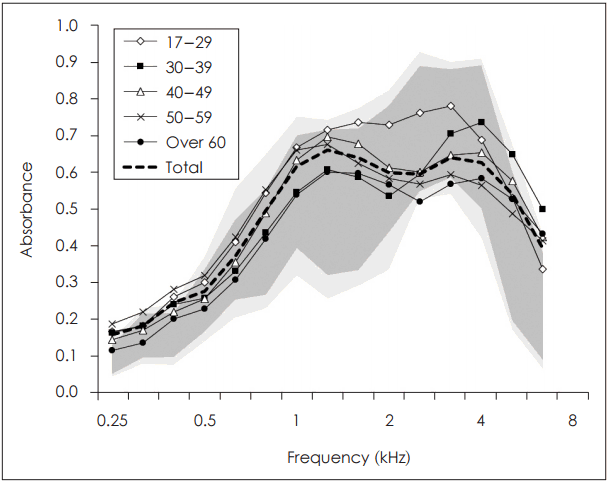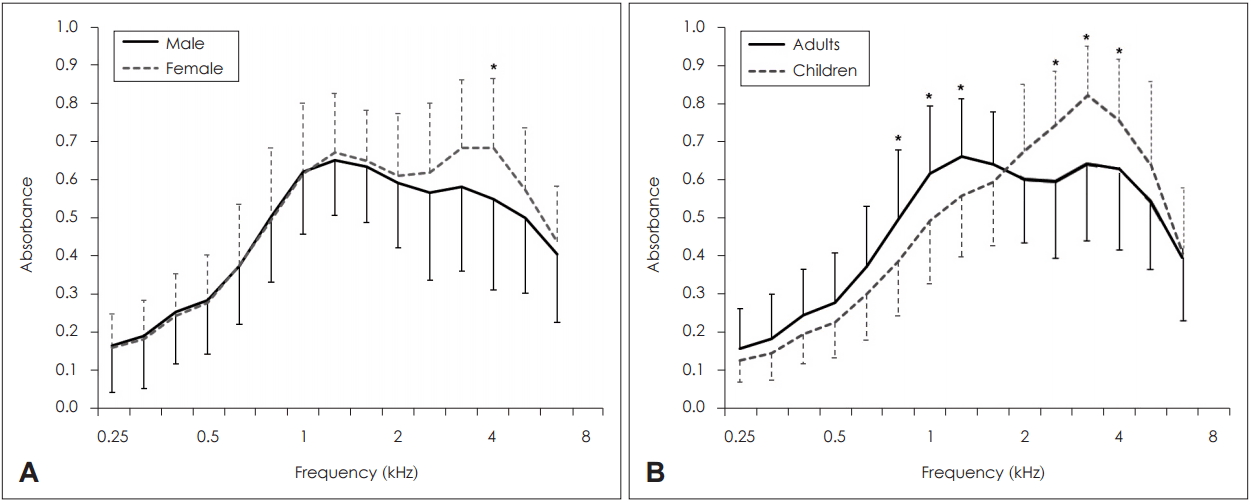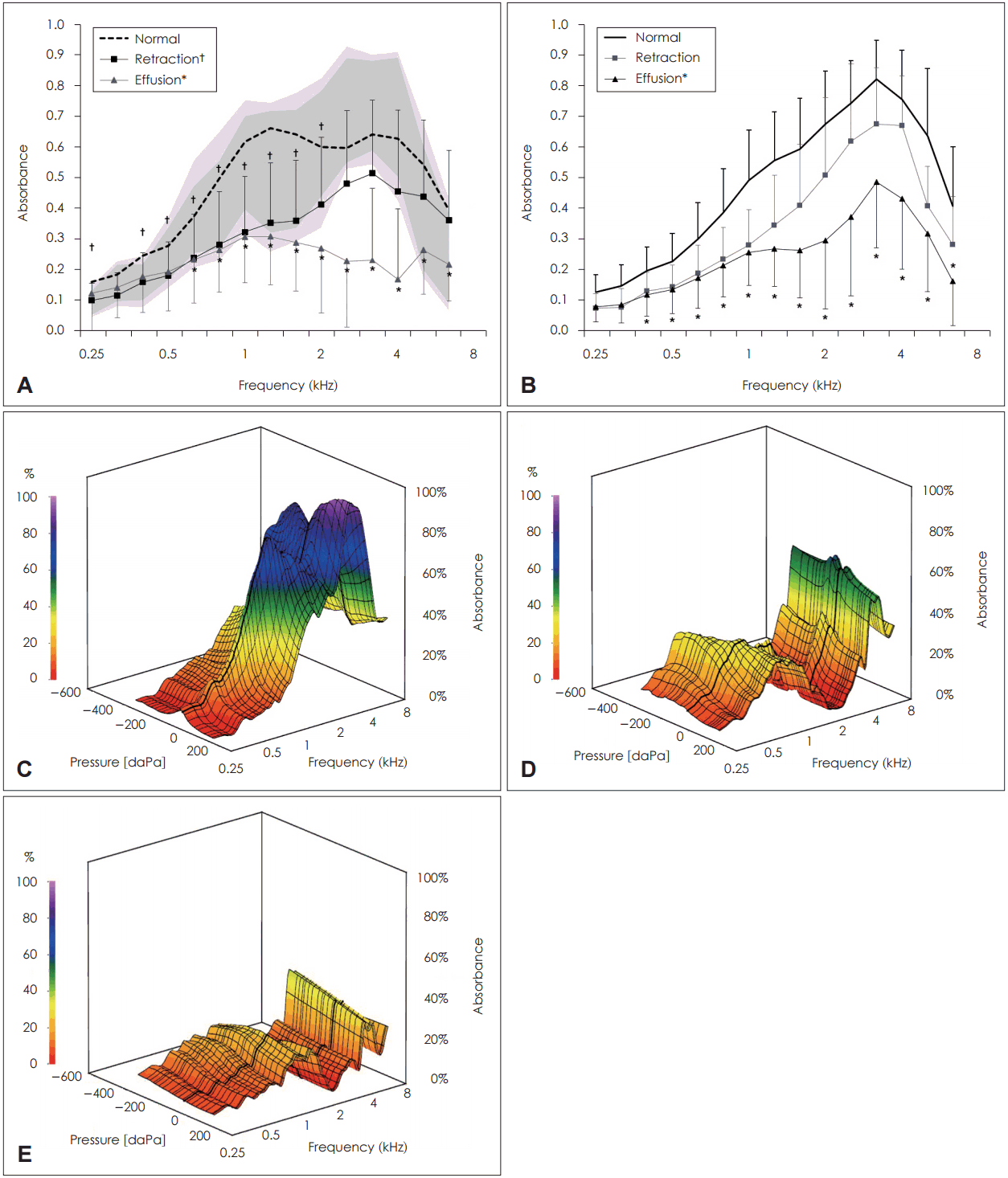1. Kim CS, Jung HW, Yoo KY. Prevalence of otitis media and allied diseases in Korea--results of a nation-wide survey, 1991. J Korean Med Sci. 1993; 8(1):34–40.

2. Kim JG, Sohn YT. Prevalence of otitis media with effusion in kindergarten children in Taegu area. Korean J Otolaryngol-Head Neck Surg. 1995; 38:1695–703.
3. Lee HJ, Park SK, Choi KY, Park SE, Chun YM, Kim KS, et al. Korean clinical practice guidelines: otitis media in children. J Korean Med Sci. 2012; 27(8):835–48.

4. Ovesen T, Paaske PB, Elbrönd O. Accuracy of an automatic impedance apparatus in a population with secretory otitis media: principles in the evaluation of tympanometrical findings. Am J Otolaryngol. 1993; 14(2):100–4.

5. Jerger J. Clinical experience with impedance audiometry. Arch Otolaryngol. 1970; 92(4):311–24.

6. Keefe DH, Bulen JC, Arehart KH, Burns EM. Ear-canal impedance and reflection coefficient in human infants and adults. J Acoust Soc Am. 1993; 94(5):2617–38.

7. Margolis RH, Goycoolea HG. Multifrequency tympanometry in normal adults. Ear Hear. 1993; 14(6):408–13.

8. Voss SE, Allen JB. Measurement of acoustic impedance and reflectance in the human ear canal. J Acoust Soc Am. 1994; 95(1):372–84.

9. Margolis RH, Hunter LL, Giebink GS. Tympanometric evaluation of middle ear function in children with otitis media. Ann Otol Rhinol Laryngol Suppl. 1994; 163:34–8.

10. Shahnaz N, Polka L. Standard and multifrequency tympanometry in normal and otosclerotic ears. Ear Hear. 1997; 18(4):326–41.

11. Margolis RH, Saly GL, Keefe DH. Wideband reflectance tympanometry in normal adults. J Acoust Soc Am. 1999; 106(1):265–80.

12. Keefe DH, Folsom RC, Gorga MP, Vohr BR, Bulen JC, Norton SJ. Identification of neonatal hearing impairment: ear-canal measurements of acoustic admittance and reflectance in neonates. Ear Hear. 2000; 21(5):443–61.

13. Feeney MP, Sanford CA. Age effects in the human middle ear: wideband acoustical measures. J Acoust Soc Am. 2004; 116(6):3546–58.

14. Vander Werff KR, Prieve BA, Georgantas LM. Test-retest reliability of wideband reflectance measures in infants under screening and diagnostic test conditions. Ear Hear. 2007; 28(5):669–81.

15. Shahnaz N, Bork K. Wideband reflectance norms for Caucasian and Chinese young adults. Ear Hear. 2006; 27(6):774–88.

16. Beers AN, Shahnaz N, Westerberg BD, Kozak FK. Wideband reflectance in normal Caucasian and Chinese school-aged children and in children with otitis media with effusion. Ear Hear. 2010; 31(2):221–33.

17. Keefe DH, Ling R, Bulen JC. Method to measure acoustic impedance and reflection coefficient. J Acoust Soc Am. 1992; 91(1):470–85.

18. Feeney MP, Grant IL, Marryott LP. Wideband energy reflectance measurements in adults with middle-ear disorders. J Speech Lang Hear Res. 2003; 46(4):901–11.

19. Keefe DH, Simmons JL. Energy transmittance predicts conductive hearing loss in older children and adults. J Acoust Soc Am. 2003; 114(6 Pt 1):3217–38.

20. Liu YW, Sanford CA, Ellison JC, Fitzpatrick DF, Gorga MP, Keefe DH. Wideband absorbance tympanometry using pressure sweeps: system development and results on adults with normal hearing. J Acoust Soc Am. 2008; 124(6):3708–19.

21. Sanford CA, Keefe DH, Liu YW, Fitzpatrick D, McCreery RW, Lewis DE, et al. Sound-conduction effects on distortion-product otoacoustic emission screening outcomes in newborn infants: test performance of wideband acoustic transfer functions and 1-kHz tympanometry. Ear Hear. 2009; 30(6):635–52.

22. Holte L, Margolis RH, Cavanaugh RM Jr. Developmental changes in multifrequency tympanograms. Audiology. 1991; 30(1):1–24.

23. Paradise JL, Smith CG, Bluestone CD. Tympanometric detection of middle ear effusion in infants and young children. Pediatrics. 1976; 58(2):198–210.

24. Cho YS, Lee DK, Lee CK, Ko MH, Lee HS. Video pneumatic otoscopy for the diagnosis of otitis media with effusion: a quantitative approach. Eur Arch Otorhinolaryngol. 2009; 266(7):967–73.
25. Cumming G, Finch S. A primer on the understanding, use, and calculation of confidence intervals that are based on central and noncentral distributions. Educ Psychol Meas. 2001; 61(4):532–74.

26. Doan DE, Erulkar JS, Saunders JC. Functional changes in the aging mouse middle ear. Hear Res. 1996; 97(1-2):174–7.

27. Werner YL, Montgomery LG, Safford SD, Igic PG, Saunders JC. How body size affects middle-ear structure and function and auditory sensitivity in gekkonoid lizards. J Exp Biol. 1998; 201(Pt 4):487–502.

28. Colin Bell A, Adair LS, Popkin BM. Ethnic differences in the association between body mass index and hypertension. Am J Epidemiol. 2002; 155(4):346–53.

29. Ellison JC, Gorga M, Cohn E, Fitzpatrick D, Sanford CA, Keefe DH. Wideband acoustic transfer functions predict middle-ear effusion. Laryngoscope. 2012; 122(4):887–94.

30. Keefe DH, Zhao F, Neely ST, Gorga MP, Vohr BR. Ear-canal acoustic admittance and reflectance effects in human neonates. I. Predictions of otoacoustic emission and auditory brainstem responses. J Acoust Soc Am. 2003; 113(1):389–406.

31. Prieve BA, Vander Werff KR, Preston JL, Georgantas L. Identification of conductive hearing loss in young infants using tympanometry and wideband reflectance. Ear Hear. 2013; 34(2):168–78.

32. Jaisinghani VJ, Paparella MM, Schachern PA, Schneider DS, Le CT. Residual mesenchyme persisting into adulthood. Am J Otolaryngol. 1999; 20(6):363–70.

33. Miura T, Suzuki C, Otani I, Omori K. [Marrow-tympanum connections in fetuses and infants]. Nihon Jibiinkoka Gakkai Kaiho. 2008; 111(1):14–20.

34. Hunter LL, Feeney MP, Lapsley Miller JA, Jeng PS, Bohning S. Wideband reflectance in newborns: normative regions and relationship to hearing-screening results. Ear Hear. 2010; 31(5):599–610.









 PDF
PDF Citation
Citation Print
Print


 XML Download
XML Download